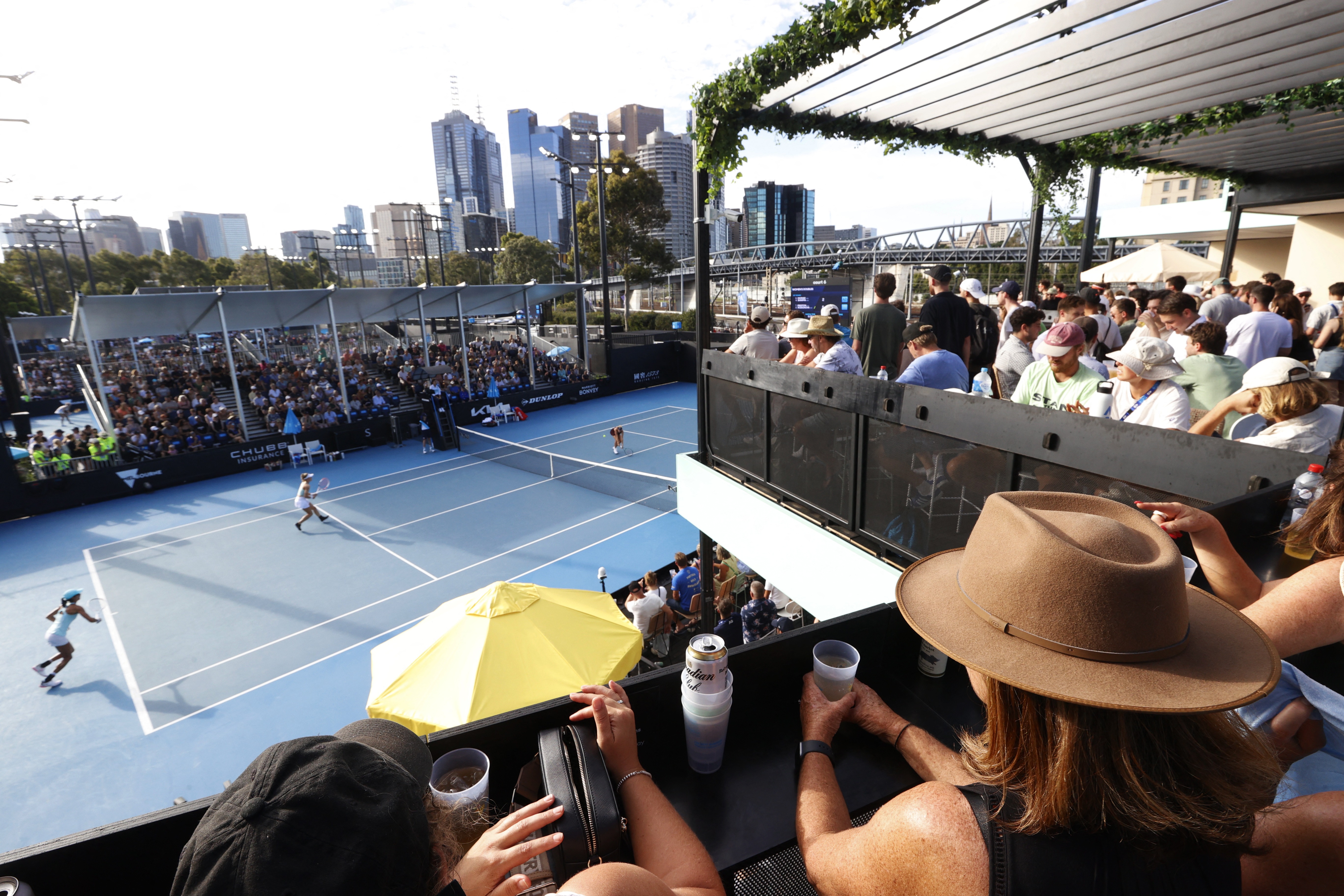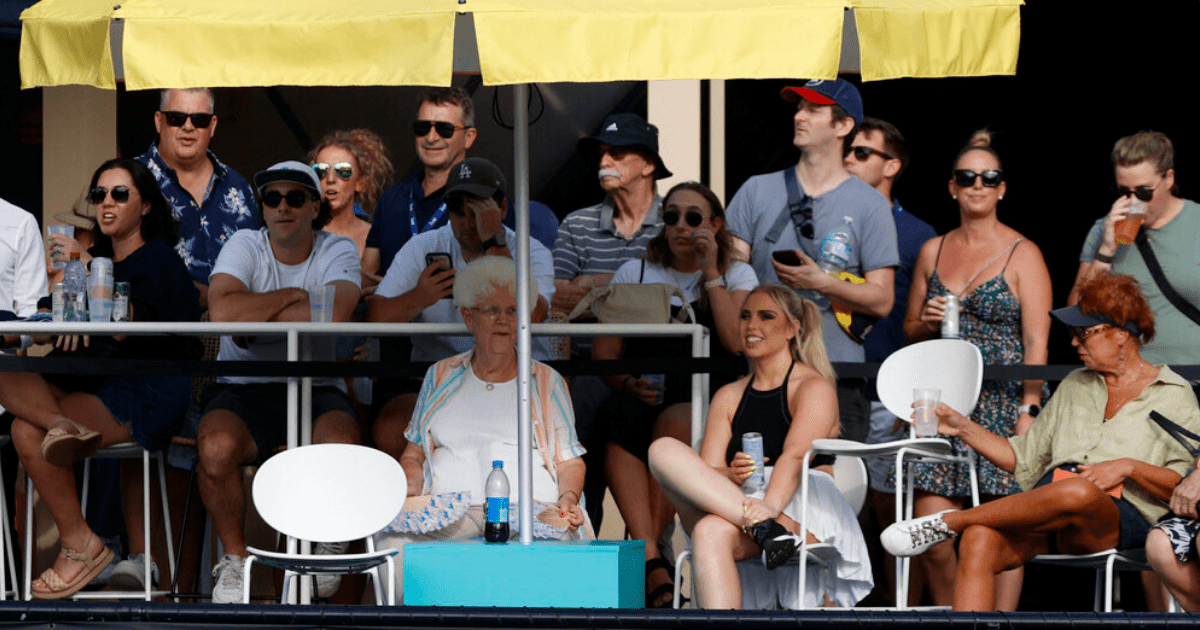Players at the Australian Open have been voicing their complaints about the distracting "party court," but fans are absolutely loving it.
What's the fuss about?
This year, a two-storey bar has been built on the eastern sideline of court six at the Australian Open tournament, creating quite the buzz.
The introduction of a bar on court six has been a hit with tennis fans.

Some players are unhappy with the rowdy crowd and the new addition.
Player complaints
Several stars, including men's No 7 seed Stefanos Tsitsipas and Russian Anastasia Pavlyuchenkova, have raised concerns about the behavior of the boozed-up fans.
Dealing with the times
However, veteran Aussie tennis star John Millman believes that players need to adapt to the changing expectations of fans and embrace the new atmosphere.

Millman, who recently retired from singles, mentioned that the rowdy behavior during a rain-interrupted match was a sign of changing times and high entertainment.
He stated, "It's just the reality of playing tennis in this day and age. It's gonna be a bit more wild than it used to be. It's definitely a lot more wild than what it was when I first started playing, but it's a lot of fun."
Player distractions
On the other hand, Tsitsipas expressed his frustration with the changes, claiming that the bar and the increased movement of spectators during breaks between games are highly distracting for players trying to focus.
He said, "You don't know until you're a tennis player, when you're trying to zone in, get in the zone, it's difficult when you see movement and when you see stuff happening around you."
Future plans
Tennis Australia's chief executive, Craig Tiley, revealed that the "party court" concept is a model they would like to expand across the entire site in the future, despite the complaints from some players.
Frequently Asked Questions
How do the different playing surfaces affect tennis matches?
Tennis matches have a huge impact on their style and pace due to the different surfaces. Grass court games are usually faster, favoring players who have an attacking style and big servers. Clay courts produce a high bounce and slow the ball down, which is beneficial to baseline players who have a strong endurance. Hard courts offer a playing surface that is balanced, neither too fast or too slow. This rewards players who are well-rounded. These differences in surfaces can lead to different strategies, and even influence the outcome of matches.
Who is credited with standardizing the modern game of tennis?
Major Walter Clopton Wingfield was largely responsible for standardizing the modern sport of tennis. In 1873, he introduced a version of the game that he called Sphairistike, which was played on an hourglass-shaped grass court. Wingfield’s version featured a simplified game scoring system, and similar equipment as is still used today. This iteration set the foundations of lawn tennis. By 1877 Wimbledon Championships, which consolidated the game’s structure and rules, were held.
What are the Grand Slam tennis tournaments?
The four Grand Slams, or Majors as they are sometimes called, are among the most prestigious tournaments in professional tennis. The Australian Open is held in January. The French Open takes place in May and in June. Wimbledon takes place in July and in June. And the US Open occurs in August. These tournaments offer a high level of competitiveness, a long history, as well as significant rankings points and prize funds. Grand Slams are considered to be one of the most prestigious achievements in tennis.
What role has tennis icons played in the popularization of the sport?
Tennis icons have played an important role in popularizing tennis around the world. Throughout history, charismatic players such as Billie Jean King and Pete Sampras have captured the imagination of the public. Their performances on court and personalities outside of it have not just drawn fans to this game, but also inspired younger players to take up tennis. Their legacies go beyond their titles. They shape the culture of tennis and its marketplace.
What is the history of tennis?
The origins are traced to the 12th Century France when monks were using their fingers to hit the balls in a jeu de Paume game played in courtyards. Over time, rackets were introduced, and the game evolved into what we recognize today as tennis. In the 16thcentury, European nobility began to play the game. Tennis has undergone numerous changes since its inception, including the development of standardized rules and the introduction of lawn tennis in the 19th century.
Statistics
- The modern game of tennis originated in England in the late 19th century, with the first Wimbledon Championship held in 1877.
- The global tennis equipment market reached an estimated value of over 1 billion dollars, reflecting the sport’s widespread popularity.
- Professional tennis players can serve the ball at speeds exceeding 150 mph, with the fastest serve recorded at 163.7 mph by Australian player Sam Groth in 2012.
- Major Walter Clopton Wingfield is often credited with pioneering the rules of modern tennis in 1873, and his version of the game was patented under the name “Sphairistikè.”
- As of 2023, Wimbledon remains the oldest tennis tournament in the world and is considered by many to be the most prestigious.
External Links
smithsonianmag.com
bbc.com
atptour.com
rolandgarros.com
tennisfame.com
How To
Tennis History Research: What to Look for?
To delve into the history of tennis, explore key historical periods starting from its origins as “real tennis” in 12th century France to its modern establishment as lawn tennis. Many libraries, online databases, archives, and sporting organizations have reference materials. Some notable milestones are the codification by Major Walter Clopton Wingfield of the rules and the introduction of prestigious events like Wimbledon. Tennis history is available in the International Tennis Hall of Fame’s books and online resources.

